
Original Link: https://www.anandtech.com/show/2205
OCZ Vindicator: Heatpipe Tower Cooling from OCZ
by Wesley Fink on April 5, 2007 4:00 AM EST- Posted in
- Cases/Cooling/PSUs
Readers who have been around the enthusiast market for a while may remember OCZ heatsink/fans from the past. OCZ was a big player in the enthusiast cooler market several years ago, but OCZ cooling solutions have been few and far between in recent years. We took a look at the somewhat traditional OCZ Tempest last year, but we could never get the Tempest to mount properly on our test bed. We did try an alternate test board but performance was not really any better than the stock Intel cooler so the cooler didn't justify a special review in our mind.
OCZ has recently introduced another enthusiast cooler, which they call the OCZ Vindicator. Those familiar with current coolers will recognize a striking resemblance to the Scythe Ninja Plus Revision B, a cooler that is also in our schedule for review.
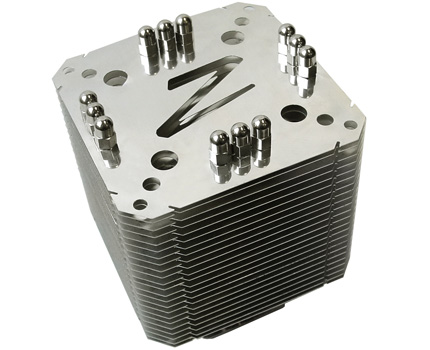
When we asked OCZ if the Vindicator was just a relabeled Ninja Rev. B they told us the Vindicator is built for OCZ. OCZ stated they did not have any agreement with Scythe and that the Vindicator is not a rebadging of the Scythe Ninja. Regardless, the designs are very similar. The good news is the OCZ Vindicator comes preconfigured for Intel Socket T, where the Scythe requires installation of a bracket before it can be used on that socket. Mounting socket plates on both coolers are similar in design, but they differ slightly in the screw layout used to attach the plates to the base cooler.
OCZ ships with an Intel 775 mount installed and an AMD AM2/939/940/754 adapter in the package. The Ninja Rev. B includes the same assortment with a slightly different design. The Ninja Rev. B also includes an Intel Socket 478 adapter.
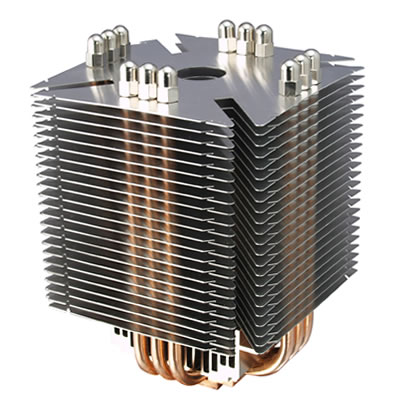
Where OCZ and Scythe differ quite a bit is in the included fan. The OCZ fan is rated at 1000 RPM, 40 CFM, and a very low 18.5 dB-A. This compares to the Ninja at 1200 RPM, 49.6 CFM, and 20.9 dB-A. Both are very quiet fans, but the OCZ is specified at almost half the sound pressure of the Ninja Rev. B. The Ninja, on the other hand, is capable of moving more air.
In the end the question is whether the OCZ fan, which is definitely quieter, is capable of moving enough air to keep up with other coolers in overclocking - a domain that is certainly a part of almost everything OCZ markets. That is a question that will be addressed in this review, when the performance of the Vindicator is compared to the other heatpipe towers we have tested in recent months.
OCZ Vindicator
The Vindicator is packaged is a slick acrylic box. This certainly allows the package to stand out on shelves, since you can see everything about the cooler through the clear shell.
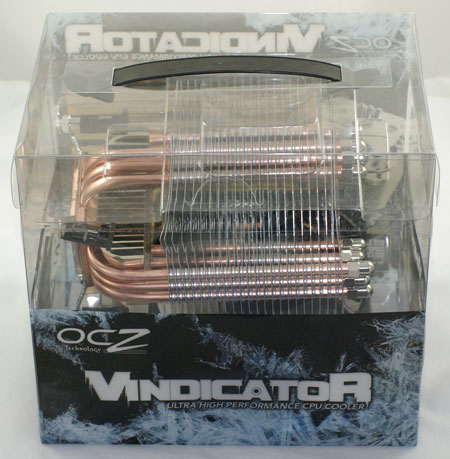
While the packaging makes the Vindicator stand out, we do have some questions about how well it protects the heatpipe tower from damage during shipment. The cooler we received looked great in the package and the package seemed sturdy enough, but the shipping process had caused a lot of crushed fins opposite the visible side of the package. They were straightened with a knife and some patience, but not all buyers will want to straighten fins on a new cooler. A sturdier package would help.
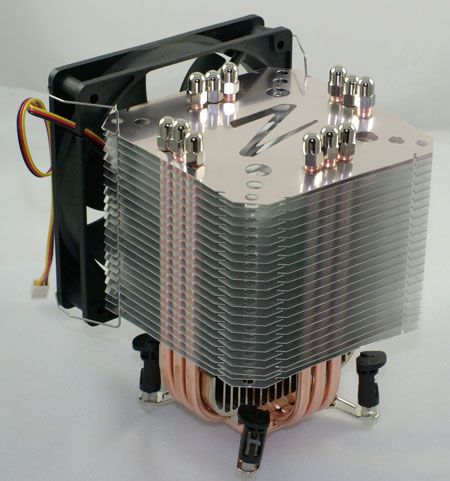
The Vindicator cooler is a bit different in configuration from most other heatpipe coolers. While it uses 6 u-shaped heatpipes to cool they are arranged as 3-pipe arrays at a ninety degree angle. This places three heatpipe rods on each side. Unlike the Scythe Infinity or Thermalright Ultra 120, which are wider than they are flat, the Vindicator design makes a square cooler which is much deeper than most of the other heatpipe coolers. This is the same configuration used in the Scythe Ninja Rev. B.
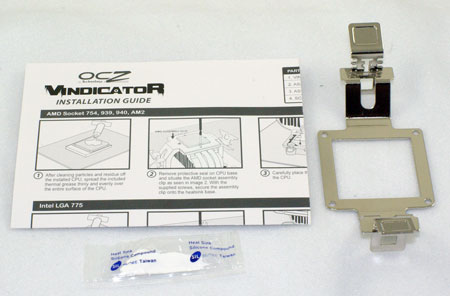
As already mentioned the Socket 775 adapter is installed, but the AM2/939/940/754 adapter is also included along with a small packet of thermal compound and installation instructions. You are not required to remove the motherboard to mount the Vindicator. It uses standard Intel-type push pins for mounting on Socket 775. However, space is very limited above the mounting area so you will likely want to mount the Vindicator before installing a fan.
The Vindicator is a big cooler and it takes up a lot of space in the case. While a simple installation is always preferred, the weight that is being supported by those four pop-in clips is a real concern. With no back plate this is not a cooler you will want to use in a system you move around. The motherboard could easily be overstressed and fail or it could actually break the board with rough handling.
Specifications
The Vindicator will mount on all current CPU sockets, but it does not support the older Intel Socket 478. If you have a Socket 478 CPU you will need to buy the Scythe Ninja Rev. B instead.
| OCZ Vindicator Specifications | |
| Heatsink | |
| Dimensions | 110(L) X 110(W) X 150(H)mm (excluding fan) |
| Weight | 640g (excluding fan) |
| Material | Copper and Aluminum |
| Fan Configuration | Supports 120mm fans (120mm fan included) Open or closed mounting posts. |
| Included Fan | |
| Fan Size | 120mm x 120mm x 25mm |
| Bearing Type | Sleeve Bearing |
| Noise Level | 18.5 dB-A |
| Speed | 1000 RPM |
| Air Flow | 40 CFM |
| Static Pressure | 1.40mm H2O |
| Weight | 130g (fan only) |
The fan included with the Vindicator is clearly aimed at the silent cooler market. The airflow is relatively low and noise is rated at just 18.5 DBA. However, the fan mount will handle any 120mm fan, so you can choose from a wide variety of popular 120mm fans if the stock fan does not deliver what you are looking for.
The Vindicator also allows mounting of multiple fans if you choose, as we demonstrated in the Scythe Infinity review. The aluminum cooling fins have a pair of grooves on each side to provide flexibility in fan mounting. Using extra wires and careful positioning you should be able to mount as many as 4 fans for cooling on the Vindicator.
CPU Cooling Test Configuration
The standard test bed for cooling tests uses an EVGA NVIDIA 680i SLI motherboard. This is primarily based on the consistent test results on this board and the excellent NVIDIA Monitor temperature measurement utility, which is part of the nTune program. The 680i chipset is also one of the better options for Socket 775 CPU overclocking, and it provides great flexibility in our standard cooler tests which overclock to the failure limit with each cooler tested.
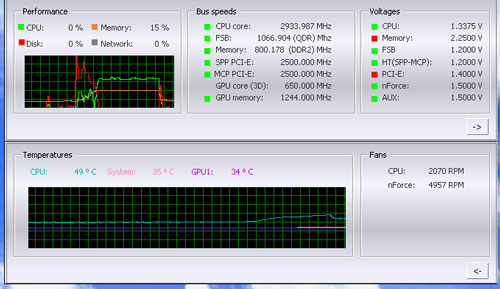
NVIDIA Monitor has a drop-down pane for temperature measurement which reports CPU, System, and GPU results. Reviews at this point will concentrate primarily on CPU temperature. In addition to the real-time temperature measurement, NVIDIA Monitor also has a logging feature which can record temperature to a file in standard increments (we selected every 4 seconds). This allows recording of temperatures during testing and play back, for example, of stress test results that can then be examined when the stress tests are completed. There is also the handy reference of speeds and voltages in the top pane to confirm the test setup.
Other components in the cooling test bed are generally the same as those used in our motherboard and memory test bed:
| Cooling Performance Test Configuration | |
| Processor | Intel Core 2 Duo X6800 (x2, 2.93GHz, 4MB Unified Cache) |
| RAM | 2x1GB Corsair Dominator PC2-8888 (DDR2-1111) |
| Hard Drive(s) | Hitachi 250GB SATA2 enabled (16MB Buffer) |
| Video Card: | 1 x EVGA 7900GTX - All Standard Tests |
| Platform Drivers: | NVIDIA 9.53 |
| NVIDIA nTune: | 5.05.22.00 (1/16/2007) |
| Video Drivers: | NVIDIA 93.71 |
| CPU Cooling: | OCZ Vindicator Thermalright Ultra 120 Extreme Thermalright Ultra 120 Scythe Infinity Zalman CNS9700 Zalman CNS9500 CoolerMaster Hyper 6+ Vigor Monsoon II Lite Thermalright MST-9775 Scythe Katana Tuniq Tower 120 Intel Stock HSF for X6800 |
| Power Supply: | OCZ PowerStream 520W |
| Motherboards: | EVGA nForce 680i SLI (NVIDIA 680i) |
| Operating System(s): | Windows XP Professional SP2 |
| BIOS | Award P24 (1/12/2007) |
All cooling tests are run with the components mounted in a standard mid-tower case. The idle and stress temperature tests are run with the case closed and standing as it would in most home setups. We do not use auxiliary fans in the test cooling case, except for the north bridge fan attached to the 680i for overclocking.
Since OCZ provides a small packet of a standard white thermal compound, we tested with a premium silver colored (no silver content) thermal compound we have used in testing coolers that did not include a proprietary thermal compound in the cooler kit.
In our experience the thermal compound used makes little to no difference in cooling test results. This is particularly true now that processors ship with a large manufacturer-installed heatspreader. Our only control on thermal compound is that we use the manufacturer-supplied product if they supply a premium product, or a standard high-quality thermal paste if a premium brand is not supplied.
We first tested the stock Intel cooler at standard X6800 speed, measuring the CPU temperature at idle and while the CPU was being stressed. We stressed the CPU by running continuous loops of the Far Cry River demo. The same tests were repeated at the highest stable overclock we could achieve with the stock cooler. Stable in this case meant the ability to handle our Far Cry looping for at least 30 minutes.
The same tests were then run on the cooler under test at stock, highest stock cooler OC speed (3.73GHz), and the highest OC that could be achieved in the same setup with the cooler being tested. This allows measurement of the cooling efficiency of the test unit compared to stock and the improvement in overclocking capabilities, if any, from using the test cooler.
Noise Levels
In addition to cooling efficiency and overclocking abilities, users shopping for CPU cooling solutions may also be interested in the noise levels of the cooling devices they are considering. Noise levels are measured with the case open on its side and are measured using a C.E.M. DT-8850 Sound Level meter. This meter allows accurate sound level measurements from 35bdB to 130dB with a resolution of 0.1dB and an accuracy of 1.5dB. This is sufficient for our needs in these tests, as measurement starts at the level of a relatively quiet room. Our own test room, with all computers and fans turned off, has a room noise level of 36.4dB.
Our procedures for measuring cooling system noise are described on page seven along with noise results comparing the stock Intel cooler and recently tested CPU coolers to the OCZ Vindicator cooler.
Additional Fan Tests
Initial test results showed the fan of the Vindicator was heavily slanted to silence. The stock fan provided average to below average results in our cooler overclocking tests. To determine whether the overclocking limitations were a result of the cooler design or the fan selection, additional cooling tests were run with a remarkable new fan we just got in for review.
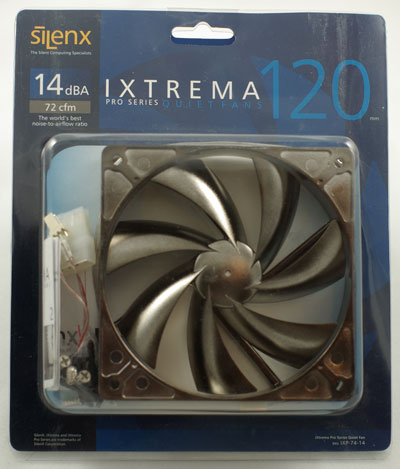
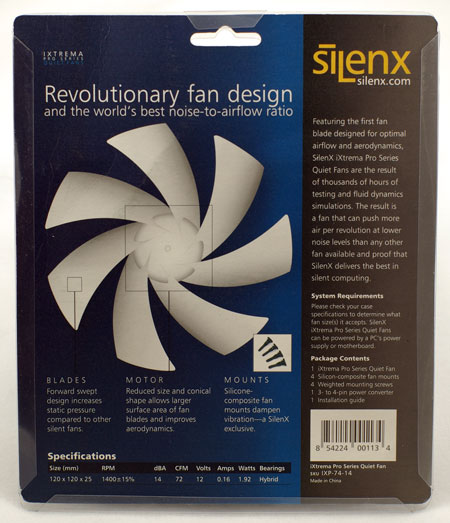
The SilenX IXTREMA 120 claims to provide the world's best noise-to-airflow ratio. The specifications certainly support that claim with an exceptional 14 dB-A noise level coupled with 72 CFM airflow. Perhaps even more remarkable is the rated watts of 1.92 which should be safe on almost any motherboard fan header.
We extend our sincere thanks to Frozen CPU for providing the SilenX IXTREMA 120 for testing. We are preparing for a roundup of 120 fans and Frozen CPU has provided an assortment of tantalizing fans that we think you will enjoy seeing in the upcoming 120 fan roundup.
The claimed low noise and high output of the SilenX fan certainly sounds attractive, so the IXTREMA was used to see if higher fan output would improve the cooling and overclocking of the OCZ Vindicator. Results with a single stock OCZ fan and a single SilenX IXTREMA 120 are reported in all performance charts and graphs.
Push-Pull Testing
Since a push-pull fan configuration made a significant improvement in our review of the Scythe Infinity cooler, push-pull was briefly tested using two stock OCZ Vindicator fans. Overclocking performance was also tested briefly using two SilenX IXTREMA 120 fans.
Push-Pull results were mixed and not directly comparable to the findings on the Infinity. A stock single OCZ Vindicator fan topped out at an overclock of 3.80Ghz. Using two of the 40 CFM fans allowed us to reach a top stable overclock of 3.87GHz - better than one fan, but still below the top heatpipe tower coolers and the push-pull Infinity.
However, a single 72 CFM SilenX allowed a top stable overclock of 3.90GHz - matching the top results with the Thermalright Ultra 120/SFLEX, Tuniq Tower 120, Cooler Master Hyper 6+, and Scythe Infinity (with two push/pull 46.5 CFM fans). This certainly points to a better fan providing better results with the OCZ Vindicator. The soon-to-be-released Thermalright Ultra 120 Extreme remains alone at the top of our performance charts with an overclock of 3.96GHz combined with temperatures among the lowest tested at each overclock.
With these results with a single SilenX we were excited to test the OCZ Vindicator with two SilenX fans. To our surprise two SilenX 72 CFM fans in a push-pull configuration provided no better overclocking than a single 72 CFM SilenX. The conclusion is that increasing airflow in the Vindicator definitely improves performance - moving it from average to a top competitor. However, increasing airflow, even with high output low-noise fans, is not without limits. Eventually you reach the point where increasing airflow provides no further improvements in cooling or overclocking. This optimum point is likely to vary with each cooler and each type of design. It is a subject we will explore further in our 120mm fan roundup.
Since results were the same with one or two SilenX fans, we report results with one SilenX fan and the stock OCZ Vindicator fan. This is also consistent with the fact that two OCZ fans in push-pull improved cooling, but not to the extent of the improvement with one SilenX IXTREMA fan.
Cooling at Stock Speed
Some users will never overclock their CPU, but they still want to run the coolest CPU temperatures possible to enhance stability and extend CPU life. The OCZ Vindicator kit includes a moderate output low noise 120mm fan. We also tested the Vindicator with the 120mm SilenX IXTREMA 120 fan.
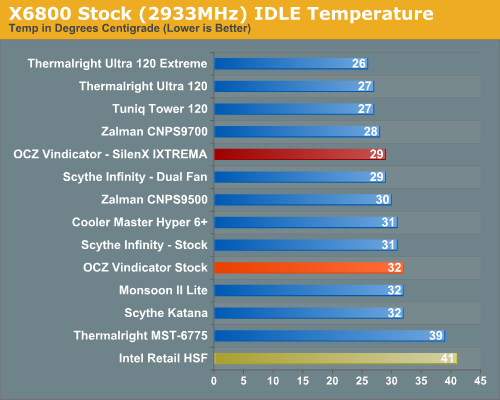
With the stock Vindicator fan the end user does get silence, but the cost is cooling among the poorest of the heatpipe towers tested at AnandTech. As soon as the switch is made to the SilenX fan you can see this cooler is starved for airflow with the stock fan. Idle temps with the SilenX drop to 29C, which is among the top tier of measured performance at stock idle in our cooler reviews
It is more difficult to effectively simulate a computer being stressed by all of the conditions it might be exposed to in different operating environments. For most home users CPU power is most taxed with contemporary gaming. Therefore our stress test simulates running a demanding contemporary game.
The Far Cry River demo is looped for 30 minutes and the CPU temperature is captured at 4 second intervals with the NVIDIA monitor "logging" option. The highest temperature during the stress test is then reported. Momentary spikes are ignored, as we report a sustained high-level temp that you would expect to find in this recording configuration.
Cooling efficiency of the OCZ Vindicator was tested under load conditions with both the stock fan and the SilenX at stock speed. Results are compared to the Intel retail HSF and other recently tested CPU coolers.
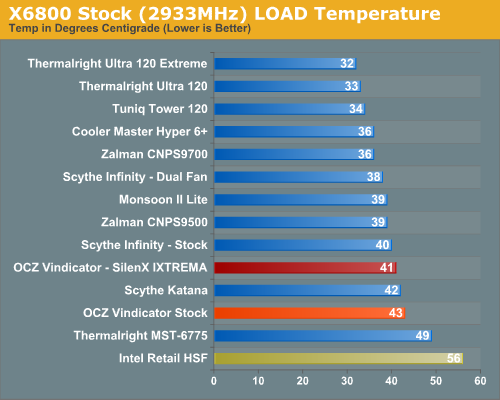
The OCZ Vindicator under load at stock speeds reached a maximum temperature of 43C with the stock cooler. Again this was among the worst load results at stock speed among the coolers tested at AnandTech. Switching to the SilenX fan improved the load temperature to 41C. This is still not a stellar result, but it is comparable to the Scythe Infinity under the same conditions. This compared to the Tuniq at 34C, the Cooler Master Hyper 6+ and Zalman 9700 at 36C, the Thermalright Ultra 120 at 33C , and the top Ultra 120 Extreme at 32C .
Scaling of Cooling Performance
The Thermalright Ultra 120 Extreme has been the top performer so far in CPU cooling at stock speeds. As overclocks were raised, the performance the Ultra 120 with the Scythe SFLEX fan maintained its cooling advantage. The OCZ Vindicator is average or below average in cooling efficiency with the stock fan. It is clear the stock fan was selected for low noise and not cooling efficiency. However, a swap to the 14 dB-A 72 CFM SilenX fan improved cooling to the levels of the Cooler Master Hyper 6+ and Scythe Infinity - two coolers that reached upper tier cooling performance in our reviews.
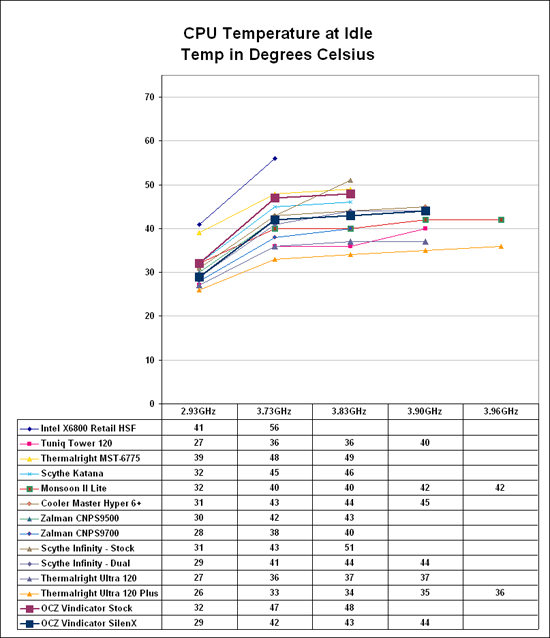
At 2.93GHz the retail HSF is running at 41C, compared to 32C with the OCZ Vindicator with the stock fan. This is a delta of 9C. The SilenX drops that temperature to 29C, or a delta of 12C. The delta increases slightly with the stock fan as the overclock increases. At 3.73GHz the idle with the retail fan is 56C compared to the Ultra 120 at 46C - a delta of 10C! Performance improvements are much greater with SilenX fan on the OCZ Vindicator. At 3.73GHZ the SilenX cools to 42C, while at the highest stable overclock of 3.90GHz the Vindicator/SilenX is at 44C. This almost straight line at idle at the top of our testing is an indication the SilenX is effectively cooling at idle all the way to the top speed that could be reached in benchmarking.
Cooling efficiency of the Vindicator, with stock and SilenX fans, was next tested under load conditions. Results are compared to the retail HSF and other recently tested CPU coolers. The OCZ Vindicator with the SilenX fan generated results similar to the Scythe Infinity with Push-Pull fans and reached the upper tier of overclocking performance. Results with the single stock fan were average at best.
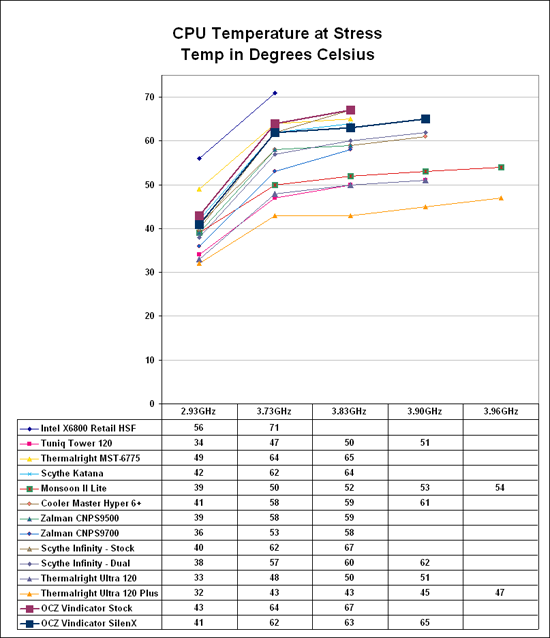
By 3.90 GHz - the highest overclock the Tuniq, Thermalright Ultra 120, and Cooler Master Hyper 6+, and push-pull Scythe Infinity could reach with stability - the Vindicator is at 65C with the SilenX fan. This is still worse performance than many of other top coolers at this speed. The Tuniq and Ultra 120 are both at 51C, which is some 14C lower than the Vindicator. Keep in mind that the Vindicator was completely stable at 3.90GHz with the SilenX fan even though it ran a bit warmer. The stock fan could only manage 3.80GHz so the SilenX is a much better fan for overclocking the OCZ Vindicator.
As stated many times, the overclocking abilities of the CPU will vary at the top, depending on the CPU. This particular CPU does higher FSB speeds than any X6800 we have tested, but the 3.9GHz top speed with the top tier heatpipe towers is pretty average among the X6800 processors we have tested with Tuniq cooling. A few of the other processors tested with the best air coolers reach just over 4 GHz, but the range has been 3.8 to 4.0GHz. Stock cooling generally tops out 200 to 400 MHz lower, depending on the CPU, on the processors tested in our lab.
Overclocking
As cooling solutions do a better job of keeping the CPU at a lower temperature, it is reasonable to expect the overclocking capabilities of the CPU will increase. In each test of a cooler we measure the highest stable overclock of a standard X6800 processor under the following conditions:
CPU Multiplier: 14x (Stock 11x)
CPU voltage: 1.5875V
FSB Voltage: 1.30V
Memory Voltage: 1.90V
nForce SPP Voltage: 1.35V
nForce MCP Voltage: 1.7V
HT nForce SPP <-> MCP:
Auto
Memory is set to Auto timings on the 680i and memory speed is linked to the FSB for the overclocking tests. This removes memory as any kind of impediment to the maximum stable overclock. Linked settings on the 680i are a 1066FSB to a memory speed of DDR2-800. As FSB is raised the linked memory speed increases in proportion. The same processor is used in all cooling tests to ensure comparable results.
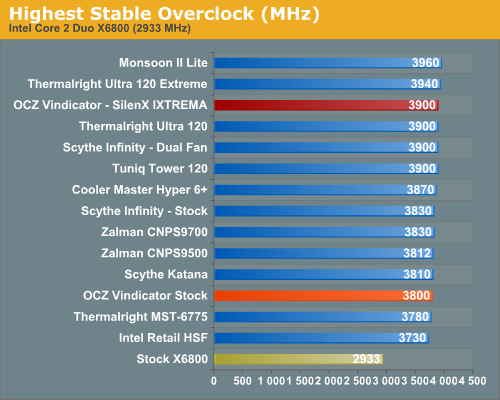
The OCZ Vindicator with the stock fan could only reach 3.80GHz overclock with stability. This result is average to below average among the tested heatpipe towers. However a change to the 72 CFM 14 dB-A SilenX IXTREMA 120 allowed us to push the overclock to 3.90GHz with complete stability. This matches the top tier of overclocks achieved by the Tuniq Tower 120, Thermalright Ultra 120/Scythe SFLEX, Cooler Master Hyper 6+, and Scythe Infinity with dual push-pull fans.
The only air cooler that has reached higher than 3.90GHz is the Thermalright Ultra 120 Extreme, which was featured at CeBIT. We managed 3.94GHz with that top air cooler. The hybrid TEC/air Monsoon II Lite reached 3.96GHz in benchmarking, but that cooler combines active TEC cooling with passive air cooling and would be expected to reach higher overclocks than an air-only solution
Noise
For many enthusiasts upgrading cooling the goal is maximum stable overclock, and they will live with the inconvenience of a louder system. For other users silence is the most important factor, and these users will forgo maximum overclocking if that increases system noise levels.
We measured noise levels with the OCZ Vindicator with both stock and SilenX IXTREMA fans under both load and idle conditions. As might be expected with fans with noise ratings of 18.5 dB-A and 14 dB-A, the measured noise was below our system noise floor at both 6" and 24" positions above the open side of our system case.
There are virtually no power supplies that do not have a fan. While Zalman and a few others do make an expensive fanless power supply, we have not seen a fanless unit larger than 500W, or one that would be used for seriously overclocking a system. With that in mind the noise level of the system with all fans turned off except the power supply was measured. The power supply used for the cooling test bed was the OCZ PowerStream 520, which is one of the quieter of the high performance power supplies.
We have also measured the Corsair 620 watt and Mushkin 650 watt power supplies which are reported to be quieter than the OCZ. Both the Corsair and Mushkin are indeed quieter at idle or start up speed. However as soon as load testing begins and the PSU fan speed kicks up and the measured noise level is almost exactly the same as the OCZ PowerStream 520 watt power supply. In keeping with our "real world" philosophy of noise, we consider the PSU load noise to be the more realistic noise level of power supplies. We do plan to evaluate additional power supplies and configurations in our upcoming 120mm fan roundup, but we will tilt to real world rather than procedures that test fans on foam blocks or hard drive noise with their "noisy" side pointed toward a foam block.
The noise level of the power supply was 38.3 dB from 24" (61cm) and 47 dB from 6" (152mm). The measured noise level of the test room is 36.4 dB, which would be considered a relatively quiet room with a noise floor slightly below the OCZ PowerStream 520 PSU.
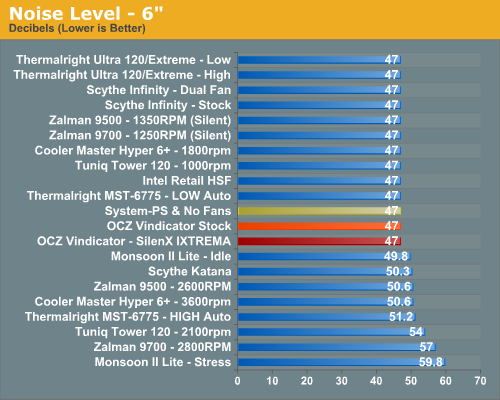
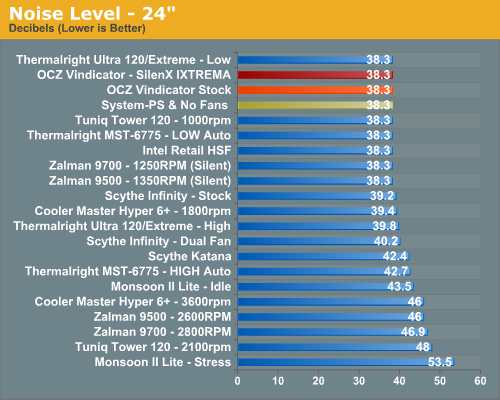
Measured noise levels in this chart should be considered worst case. Measurements were taken with an open side of a mid tower case 6" and 24" from the HSF. Real world would be a completely closed case resulting in a further reduction in noise.
Any 120mm fan should be mountable on the OCZ Vindicator. The fan clips connect to the outside mount hole, which means both open post and the more common closed post fans will work properly. The stock OCZ fan is closed post and the SilenX is open post. This means the SilenX will work on any cooler we have reviewed thus far - including the Thermalright Ultra 120 and Ultra 120 Extreme.
Final Words
The OCZ Vindicator is a full heatpipe tower that is designed to be used with one or more 120mm cooling fans. OCZ also claims that the Vindicator can be used to cool at stock speeds with no fan at all. That is probably true, but our current case setup is really not optimized with cooling paths for fanless cooling. With the barely average results achieved with the stock Vindicator fan it seemed unfair to test and report less than stellar fanless results with a cooling setup not really geared to fanless cooling. We will be making changes to our cooler test bed in the near future, with the goal of realistically reducing noise and improving case airflow using means available to our readers.
The Vindicator is produced in the same plant as the Scythe Ninja Plus Revision B, so it is understandable that the OCZ cooler bears a striking resemblance to the Ninja Plus B. OCZ ships the Vindicator preassembled for Socket T (Socket 775), so it is ready to install on today's most common enthusiast CPU - Core 2 Duo or Core 2 Quad. OCZ also includes an easy to mount adapter for AMD Socket AM2/939/940/754. The Vindicator therefore fits all current production processors and most recent CPUs except for Intel Socket 478.
The stock Vindicator fan is clearly designed for low noise first. With a meager 40 CFM output and 18.5 dB-A noise rating it is a great cooler for a low-noise PC just as it comes from the kit. If your goal in purchasing a new cooler is silence you will be happy with the full OCZ stock package. The Vindicator name does suggest more though, and overclocking is one arena where OCZ is always a player.
The problem with overclocking, however, is the anemic output of the stock Vindicator fan. If you push overclocking with the Vindicator as far as it will go you end up with a stable overclock on our test bed of 3.80GHz. This is average to below average among the heatpipe tower coolers we have reviewed. Fortunately this problem can be corrected and the Vindicator is capable of much more. Replace the stock fan with the quiet (14 dB-A) and powerful (72 CFM) SilenX IXTREMA 120 and the Vindicator can overclock with the best.
The OCZ Vindicator with the SilenX reached a stable 3.90GHz, which matches the top tier of cooler performance we have tested. This matches the excellent Tuniq Tower 120, Thermalright Ultra 120, Cooler Master Hyper 6+ and the Scythe Infinity with two fans in a push-pull configuration. You can achieve similar but slightly lower results by using two OCZ fans, or similar quiet medium output fans in a dual push-pull arrangement. However two SilenX in push-pull did not really allow a higher overclock, so there is a limit to how much increased airflow will benefit the performance of an air cooler.
For OCZ, the Vindicator is said to be the first in a much expanded line of CPU coolers. We look forward to testing the upcoming OCZ coolers, but we hope the new coolers will be a little more original that the Vindicator. Performance does differ from the similar Scythe Ninja Plus Rev. B primarily because a different fan is used, but the cooler itself is a Ninja Plus Rev. B with a different cut-out design on the aluminum fins.
If you want a quiet PC and modest overclocking you will be very happy with the stock OCZ kit. It is quiet and cools reasonably well. If you are an enthusiast who overclocks, buy another fan and clips and do push-pull for improved performance. For top overclocking performance throw away the stock OCZ fan and substitute something like the super quiet/high output SilenX or the Scythe SFLEX SFF21F. With a better matched fan you can reach the performance levels of the best air coolers available.
However, no matter what you do the OCZ is not quite as effective at lowering temperatures as the Tuniq Tower 120 or the Thermalright Ultra 120/Ultra 120 Extreme. The Vindicator with a better-matched fan will not hold back your overclocking attempts, but cooling is not in the same league as the top Tuniq and Thermalright coolers we have evaluated at AnandTech.
The OCZ Vindicator is a great beginning to an expanded OCZ cooler line. We liked OCZ coolers when they were more plentiful a few years ago. OCZ has that cooler background to be tapped in expanding their cooler product line. We look forward to seeing many new designs as OCZ establishes and expands their selection of cooling products.







